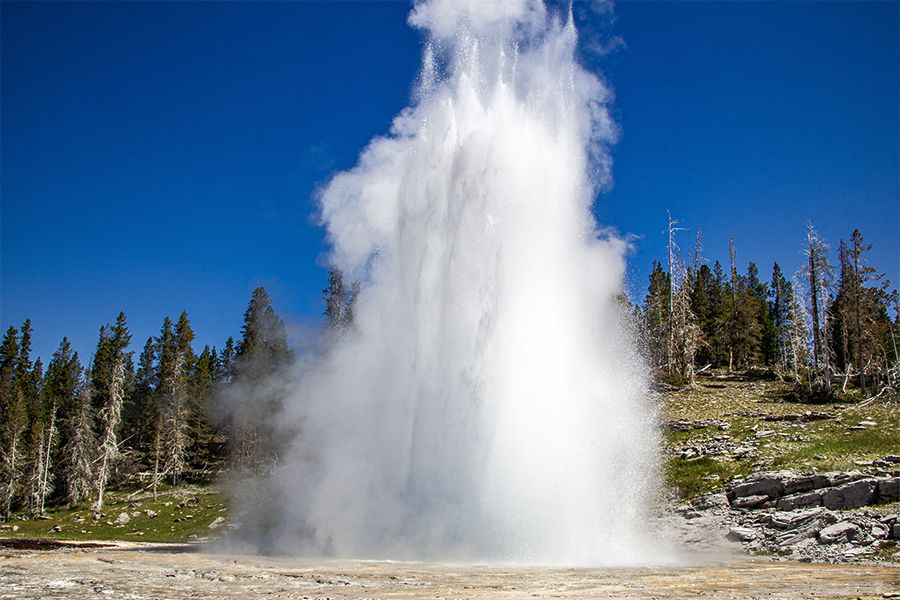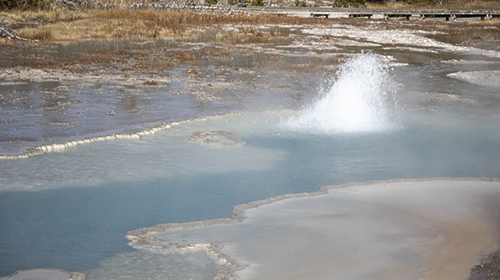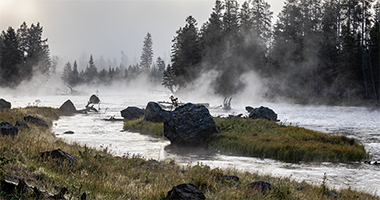Grand Geyser

Grand Geyser is in the Upper Geyser Basin north of Old Faithful Geyser. Grand Geyser puts on a fantastic show with its neighbors, Turban and Vent Geysers, and is a must-see whenever you are in the Old Faithful area.
Like Old Faithful Geyser, there is seating for you to wait for and watch the eruption. This area lacks shade and can get extremely hot during the summer. You are advised to carry plenty of water for everyone in your party and drink while you wait. That wait can be considerable, depending on the current window. Your wait may be 2-4 hours. That said, it is absolutely worth the wait, but planning is encouraged.


Grand Geyser is a fountain-type geyser, the most common type in Yellowstone. A fountain-type geyser erupts from a pool, typically has no cone formation around it, and splashes the water and steam instead of sending up jets of water.
Grand Geyser is one of only six predicted geysers in the park.
Grand Geyser has a long interval, the time from the start of the last eruption to the beginning of the current eruption. Over the last several years, the interval has ranged from 6 to 7.5 hours. The window was between 45 minutes and 2 hours on either side of the predicted time. Yes, timing can change sometimes several times in the season as rangers monitor and adjust times to ensure as many visitors as possible can see this wonder of Yellowstone.
Those geysers can be predicted because they are thought to have separate plumbing systems from those around them, so their behavior is not affected by other geysers. But remember, it is only a prediction, not a guarantee.
Many geysers have pre-eruption indicators or preplay activity. One of Grand's pre-eruption indicators is the Turban Geyser. Turban Geyser is the most apparent geyser at Grand's location. Turban sets higher than Grand's pool. Turban erupts every 17 - 25 minutes and splashes for about 5 minutes each time. When Turban erupts, the water level in Grand's pool will drop. During one eruption of Turban Grand's pool, the water level doesn't appear to fall. Then, you will see a ripple of waves in Grand's pool, which usually signals Grand's forthcoming eruption. That said, Grand has erupted without a Turban occasionally, and Grand doesn't always erupt when you see "waves on Grand."


Vent Geyser sets to the left of Turban Geyser. Once Grand's eruption starts, Vent Geyser will start and can send water 70 feet in the air that settles down to about 35 feet. After Grand stops erupting, Vent and Turban Geysers will continue to erupt for about the next hour.
Grand is different from all the other predicted geysers. Grand eruptions involve three geysers, both fountain and cone geysers.
To complicate an eruption of Grand Geyser is Rift Geyser, which is to the right of Grand. If Rift erupts near the time of a Grand Geyser prediction, Grand's eruption can be delayed..
Grand Geyser is a burst geyser, meaning it can erupt more than once. Whereas Old Faithful reaches its maximum height only once in an eruption. Grand can erupt over 100 feet on the first burst and up to 200 feet or more with following bursts. Making it the tallest predicted geyser in the world.
A Grand burst can have multiple splashes of water. A burst ends when the water drains and exposes the rocks in the basin. So stand by if the geyser erupts once and goes through its cycle, and the pool refills rapidly after the first burst. Because it will have another burst that can go to the higher heights. Most eruptions of Grand Geyser are single bursts. A 1983 eruption had a mind-blowing 11 bursts! The first burst lasted 8-10 minutes. Later bursts were much shorter.

Grand in its glory. Grand is a burst geyser, meaning it can erupt more than once during an eruption. Once it stops, never leave until you don't see water refilling the basin.















